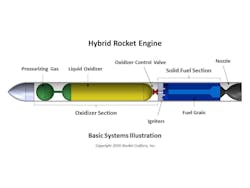Will 3D-Printing Prepare Hybrid Rocket for Takeoff?
The Defense Advanced Research Projects Agency (DARPA) awards a $542,600 research contract to Rocket Crafters, Inc. (RCI) to design, build, and test a large chemical hybrid rocket engine (HRE). The engine is described as hybrid because its oxidizer is a liquid and its fuel is a solid. These are separated to prevent accidental detonation, as shown in the patent drawing above.
HREs are eyed for their ability to be throttled, stopped, and restarted during flight—albeit, not as reliably as liquid rockets. Therefore, under the DARPA agreement, RCI will design, build, and throttle-test a flight-capable rocket motor with controllable throttling performance and lower vibrations than existing hybrid designs.
The rocket's fuel grains will be specially tailored through 3D printing to burn predictably and improve rocket performance. RCI will use its patented Direct-Digital Advanced Rocket Technology (D-DART) to 3D print near-uniform fuel grains made of the company’s high-energy polymer/additive formula. The D-DART fuel grains will be used as the engine’s fuel source, as well as in the engine combustor.
Already, RCI’s initial test series achieved thrust profiles with 97.5% consistency without signs of combustion instability or vibration—a level of performance that is a first for hybrid rocket engines. In its next prototype, RCI aims to achieve 5,000 lbf of peak thrust in its HRE prototype with controllable throttling and lower levels of vibration.
RCI will continue to work with researchers from the Florida Institute of Technology to research solid-fuel formulations and oxidizer/fuel mixtures that will be optimal in its HRE. Testing will be conducted at Florida's Space Coast using a custom static test oxidizer system mounted onto a new hybrid rocket test stand.Testing is expected to verify the hybrid rocket engine's reliability and consistency, as well as its throttling and emergency engine-shutdown capabilities.
About the Author
Leah Scully
Associate Content Producer
Leah Scully is a graduate of The College of New Jersey. She has a BS degree in Biomedical Engineering with a mechanical specialization. Leah is responsible for Machine Design’s news items that cover industry trends, research, and applied science and engineering, along with product galleries. Visit her on Facebook, or view her profile on LinkedIn.
